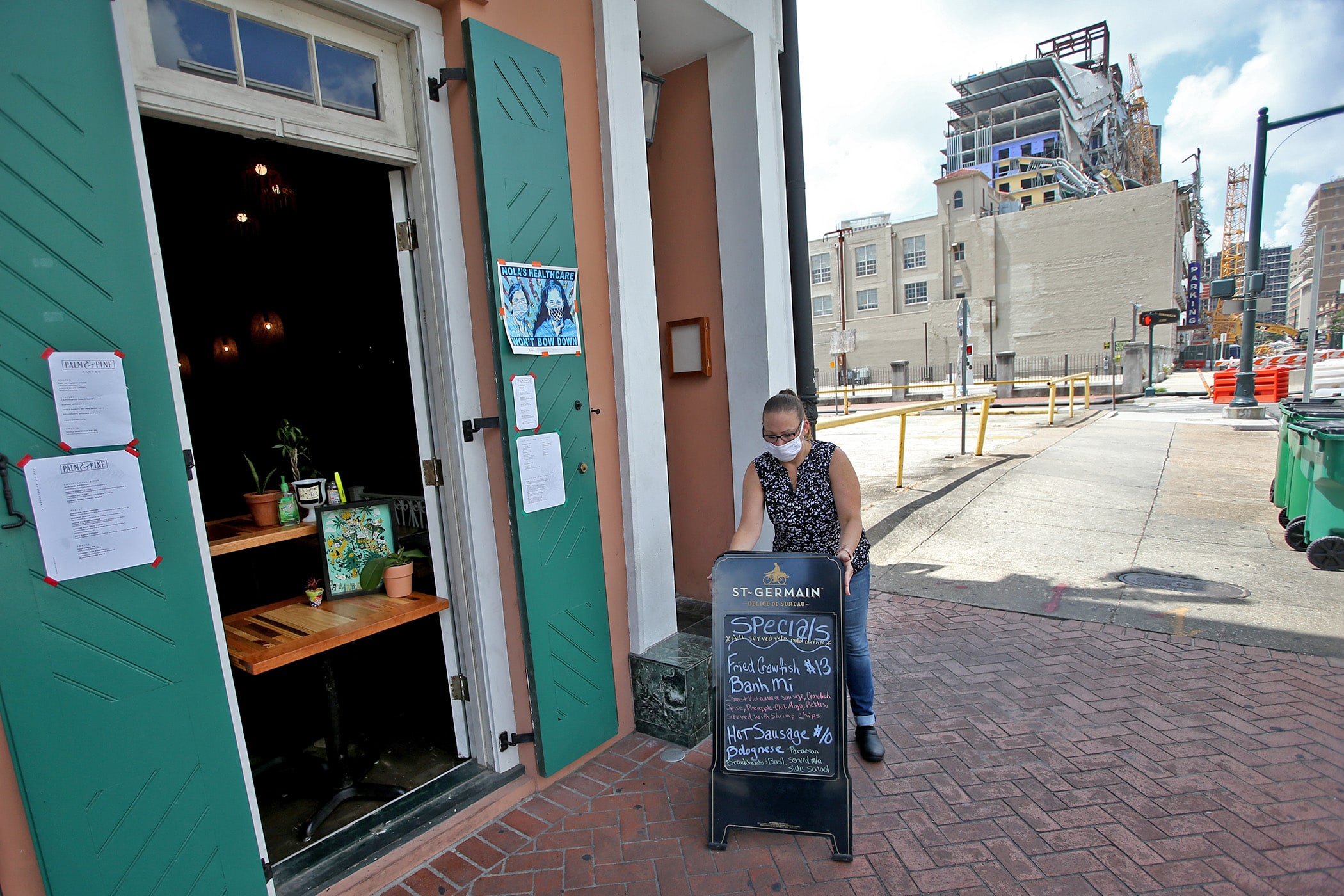Street flooding. A hotel collapse. Coronavirus. Amarys and Jordan Herndon, chef-owners of Palm & Pine on North Rampart Street, could host a master class on running a restaurant amid crisis. Not that they want to.
The ability to adapt is “just a part of our DNA now,” Jordan Herndon said.
Palm & Pine was barely three months old when the partially-built Hard Rock Hotel collapsed a block away on Oct. 12, 2019, killing three workers, injuring dozens of others and sending debris cascading down to the Canal and Rampart intersection. The bodies of Jose Ponce Arreola and Quinnyon “Q” Wimberly, who worked at the site, remain trapped inside the structure, which has stood mangled on the city’s skyline for seven months.
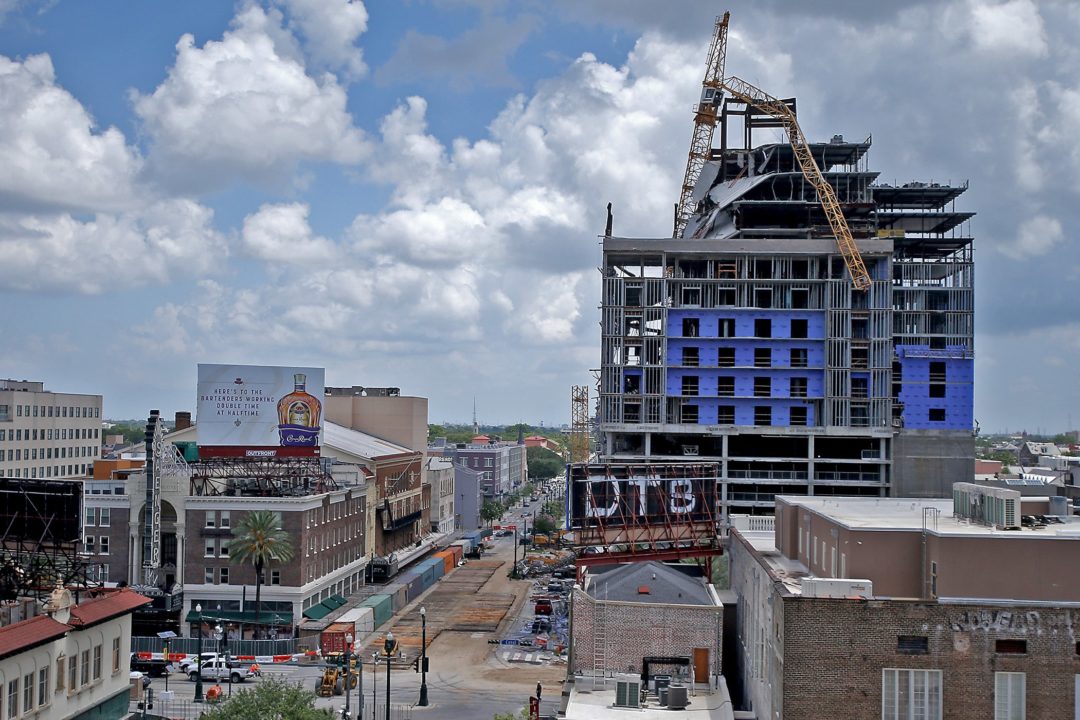
The Hard Rock collapsed just after 9 a.m. on a Saturday. Palm & Pine was fully booked for dinner that night. Instead, Amarys Herndon said the restaurant had to close as officials blocked nearby roads and figured out what to do next. Basic utilities like gas would go out without warning, she added.
Palm & Pine, which the Herndons run with partner Andy Principe, was up and running again in March when coronavirus restrictions took effect, forcing doors closed yet again. The restaurant returned with takeout and adjusted hours, but sales are a sliver of what they would have been, they said.
Now, as New Orleans loosens coronavirus restrictions on businesses, the Hard Rock Hotel saga is entering its next chapter.
“We’re going to try to be as optimistic as possible, to seek as much information as we can and try to not to let it affect us,” Amarys Herndon said.
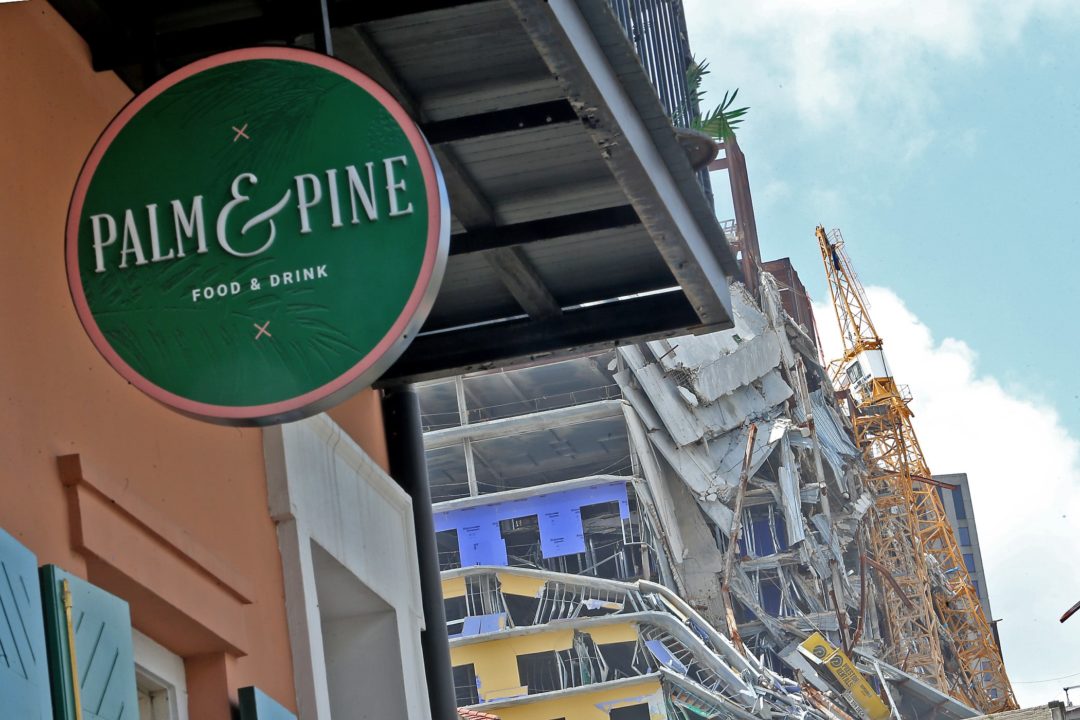
Demolition set to extend through fall
In mid-May, the Hard Rock’s developer, 1031 Canal Development LLC, said it would move forward with demolition, bringing an abrupt end to a months-long standoff between Mayor LaToya Cantrell’s administration over how to take apart the mangled hotel. The developer is footing the bill, but one point of contention was whether there was enough insurance in place to cover damage or mishaps from the work.
Work began in late May to remove three historic buildings located next to the partially-collapsed hotel. Crews also started removing the damaged tower crane that was the focus of a November 2019 dynamite blast. The next step is picking apart the hotel structure using cranes. Efforts to recover the bodies of Magrette and Wimberly will start in early June.
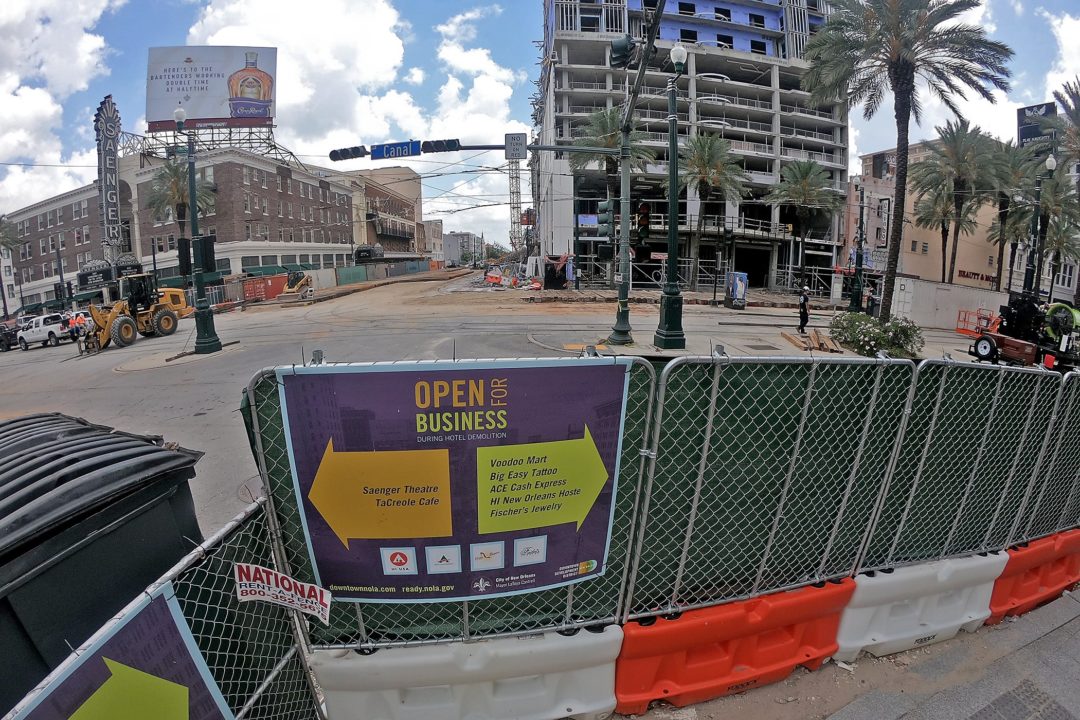
On a recent call with nearby businesses, Walter Zehner, an engineer on the project, said demolition work is set to be completed in October, The Times-Picayune | The New Orleans Advocate reported.
The site will be reduced to a slab, at which point the city will have to decide what steps are needed to secure the corner and keep it up to code, said Tammie Jackson, interim director of the city’s safety and permits department. Jackson, an assistant city attorney, was appointed interim director in March following a department shakeup. Inspectors were accused of approving conditions at the Hard Rock and other construction projects without setting foot on site.
Feelings are mixed among neighboring businesses.
Everyone is relieved the Hard Rock is finally coming down, and at a time when there will be fewer people around. At the same time, the demolition adds to the pressure cooker of uncertainty that is reopening amid COVID-19.
“For nothing to be there, that would be great,” Jordan Herndon said.
Jennifer Weishaupt, founder and CEO of Ruby Slipper Cafe, which has a location on Canal Street steps from the Hard Rock, is cautiously optimistic. From unprecedented street flooding to the collapse, the restaurant has been closed for most of the past year, she said. She knows better than to guess at a reopening date.
“We just have to be patient on when the timing of that is,” Weishaupt said.
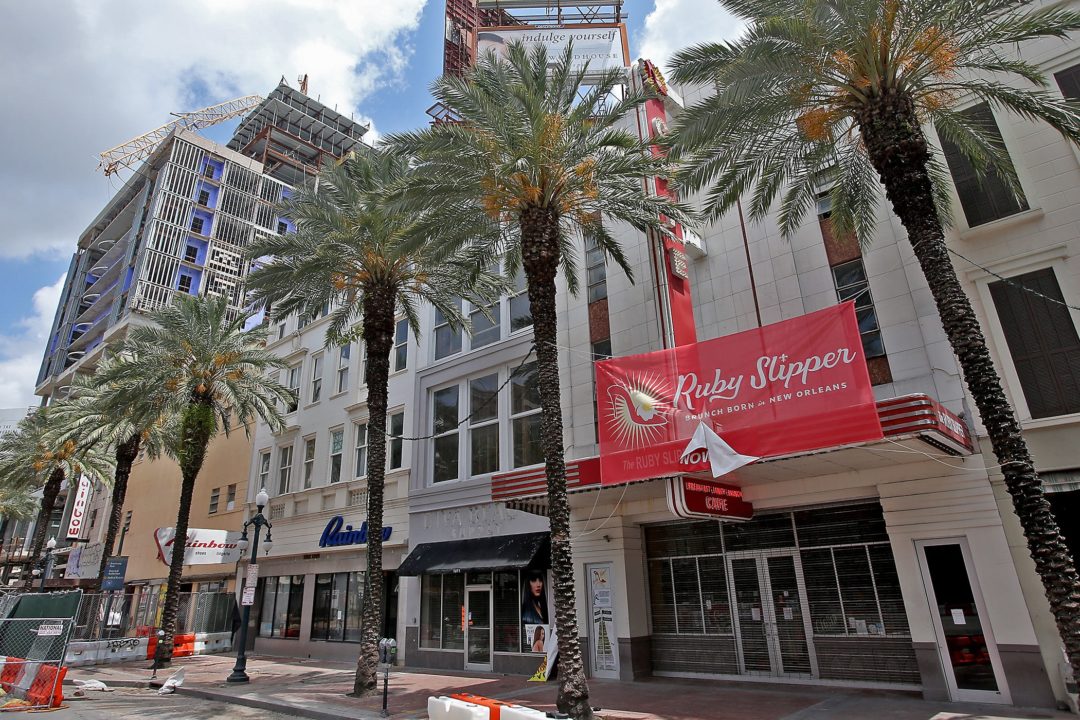
A rich past, troubled present
There’s plenty of history—and controversy—at 1031 Canal St. The corner has been a part of the city since its founding. Passers-by in the late 18th Century would have found a fortress wall topped with a Spanish-era bastion, Richard Campanella, a historical geographer and author with Tulane University School of Architecture, noted in an email.
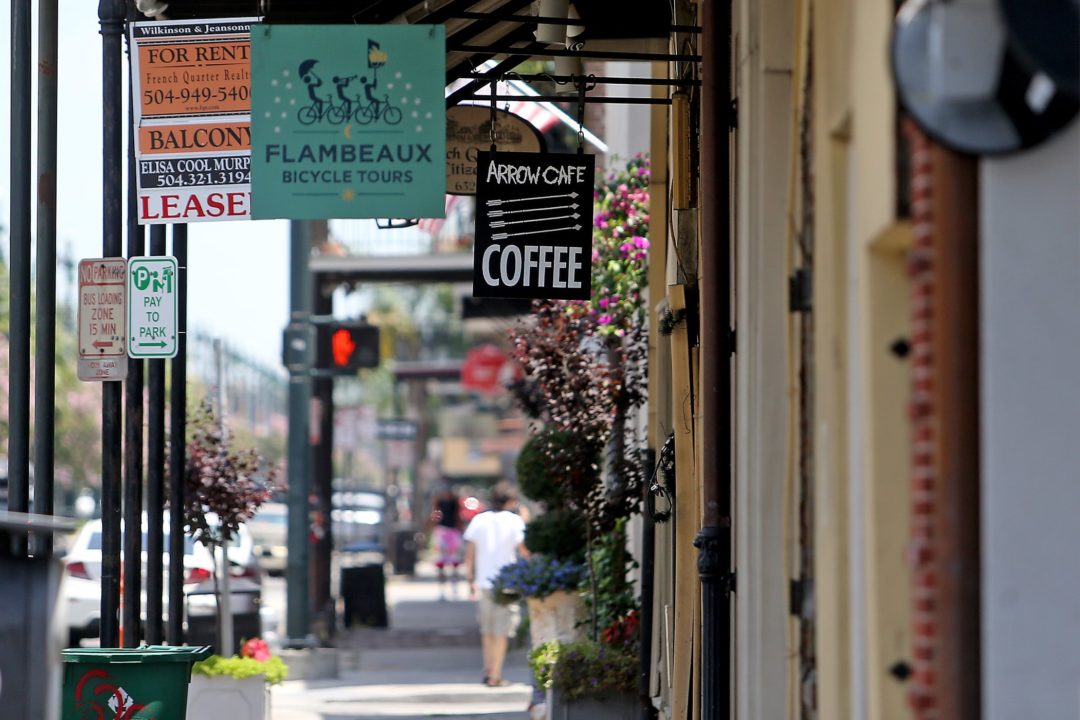
By the mid-1900s, the intersection at Canal and Rampart was part of the city’s vibrant theater district as well as a nexus for streetcar and bus lines, Campanella said. (The Saenger Theater was built in 1927.)
For decades, 1031 Canal was home to a Woolworth’s store, the site of lunch-counter sit-ins during the Civil Rights Era. The building was demolished in 2014 to make way for what would become the Hard Rock Hotel despite outcry from preservationists. Adding to the controversy, developers were given the OK to build up to 190 feet. The height waiver was more than double what zoning rules at the time allowed.
This summer’s demolition will forever change the character of the block. In May, the New Orleans Fire Department issued an emergency order to demolish three historic buildings adjacent to the collapsed hotel. Officials cited the impending hurricane season and the need to at last retrieve the bodies of Arreola and Wimberly for the order.
In addition to the partially collapsed Hard Rock structure, crews will remove three adjacent buildings, including the old Post Office at 1022 Iberville St., and the former Alamo Theater at 1027 Canal St. Each dates back to at least the early 1900s.
Erin Holmes, executive director of Vieux Carre Property Owners, Residents and Associates, a preservation advocate, said neighbors are ready for the Hard Rock to come down, but it comes at a cost.
“In the long-run, this is going to be a scar on the corner of one of the main entrances to the French Quarter,” Holmes said.
Neighbors want ‘transparency’ as demolition progresses
At City Hall, Jackson said the main priorities are ensuring a safe demolition and that the bodies of Arreola and Wimberly are returned to their families. The existing road closures will remain in place, and no expanded closures are expected at this time, she said. She added that locals can use NOLA Ready to get updates on the work.
“For us having some transparency with what’s going on over there is really important to us,” Jordan Herndon said. “We can’t find out a week before, a day before that things could close our block. That’s something that’s been frustrating.”
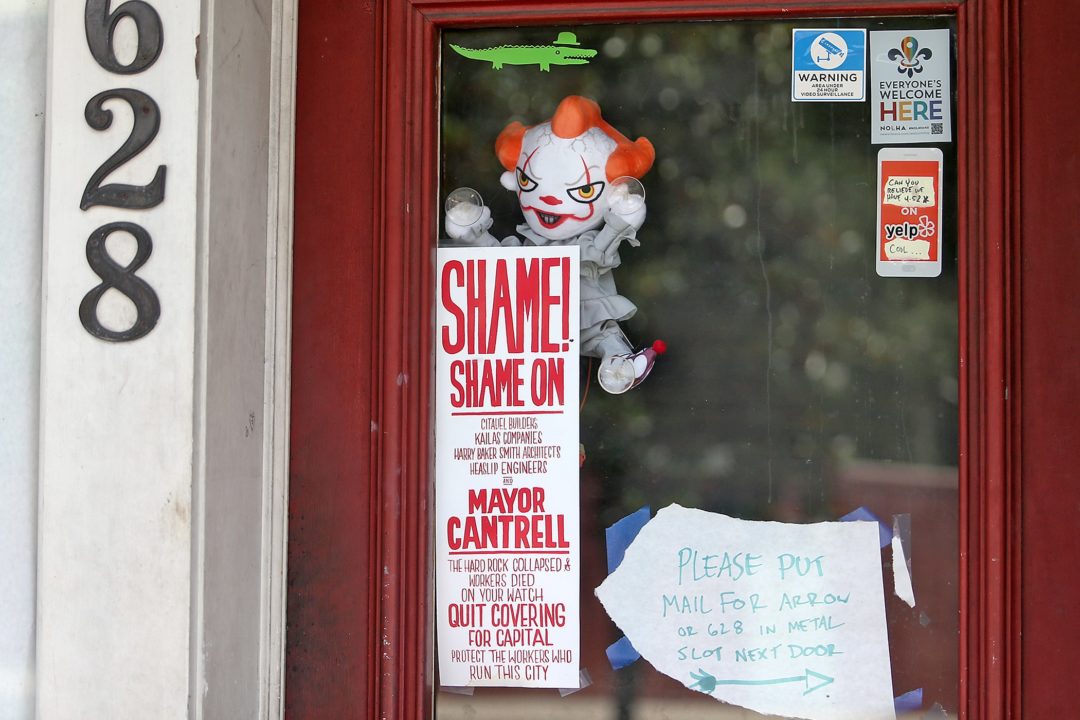
Weishaupt said her team was given a few days’ notice to retrieve computer systems and other key equipment from the Ruby Slipper Cafe at 1005 Canal St. Her team has been managing phased reopenings at the build of its 16 restaurants in four states. Still, she said details on the demolition have been sporadic.
Jackson said 1031 Canal Development is responsible for keeping nearby businesses up-to-speed on the demolition. Recently, the focus has been on businesses within a 500-foot radius of the work zone, she added.
Nearby businesses say the Hard Rock’s impact—and the need for info—extends well beyond that.
Sarah Corsiatto, who co-owns Arrow Cafe at 628 N. Rampart St. with Nicholas Christian, said the collapse and resulting closure of the Rampart streetcar line hit the community coffee shop hard. Corsiatto estimates the shop’s sales plummeted $11,000 in the eight weeks following the collapse, including a $1,200 shortfall the day of the November crane blast.
“That’s our rent for the year, almost,” Corsiatto said, adding that businesses not immediately in the demolition zone have “been told repeatedly to suck it up.”
That was before COVID-19. Now, Arrow Cafe is closed save for deliveries to customers. The shop won’t be fully open for the foreseeable future (the health concerns are many and varied, Corsiatto said), but they plan to launch a walk-up window on June 15.
In addition to coffee, Corsiatto said they’ve purchased a snoball machine and plan to team with local bartenders like Chris Hannah to develop specialty syrups. A dollar from each snoball served will go to support the bartenders, Corsiatto said.
Corsiatto said the walk-up arrangement will give Arrow Cafe the flexibility to close up on short notice, which they suspect they’ll need to as the demolition continues.
Corsiatto is optimistic Rampart Street businesses will get back to “being OK.” It’s “just going to take a lot longer than it would in normal times,” Corsiatto said.
What’s next?
It will be a while before the intersection at Canal and North Rampart streets can fully move past the collapse. The site’s future will depend upon litigation over the disaster, which will be tied up in court for years. For their part, the Hard Rock developers haven’t discussed any plans for the site beyond demolition.
Some, like Corsiatto, would like to see a park or green space. Holmes said a monument to the men who lost their lives should be erected. Everyone wants to see the streetcar line back.
Weishaupt said Ruby Slipper Cafe is committed to the Canal Street location, which it’s run since 2014. When it’s open, it’s a top performer, she said.
“It’s so highly visible on Canal Street,” she said. “It really is an important part of who we are as a company.”
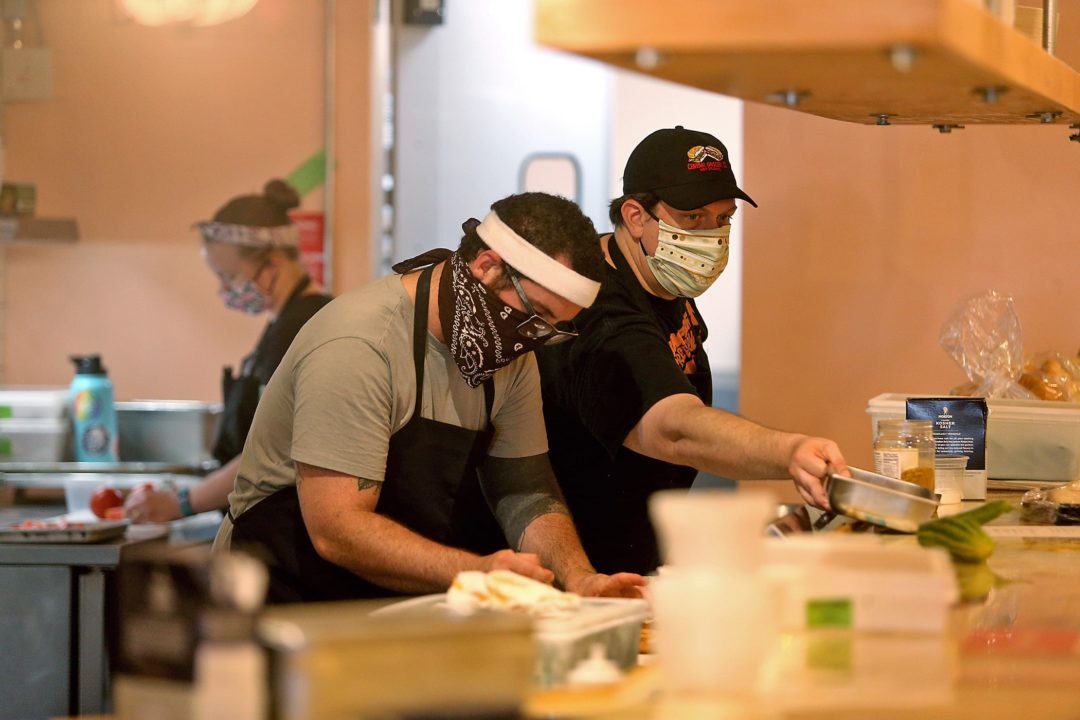
At Palm & Pine, the Herndons would eventually like to see something built on the corner. For now, they want to see the Saenger Theater busy again. The theater was damaged in the collapse and re-opened before coronavirus closures. It’s not yet clear how and when theaters, arenas and similar venues will re-open amid COVID-19.
“I just want that corner to be brought back to life,” Jordan Herndon said.

